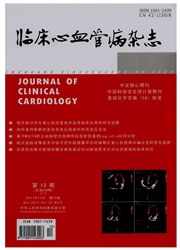

 中文摘要:
中文摘要:
目的:研究卡维地洛对阿霉素心肌病兔氧化应激的影响,并探讨氧化应激与慢性心肌毒性之间的关系。方法:将40只日本长耳白兔随机分为对照组、阿霉素组、美托洛尔组和卡维地洛组,每组各10只。耳缘静脉注射阿霉素(每次1ml.kg-1,每周2次,共8周)建立阿霉素心肌病模型,对照组采用耳缘静脉注射0.9%氯化钠(每次1ml.kg-1,每周2次,共8周)。3周后,对照组和阿霉素组以0.9%氯化钠(5ml.kg-1.d-1)灌胃,美托洛尔组和卡维地洛组分别给予美托洛尔(5mg.kg-1.d-1)和卡维地洛(5mg.kg-1.d-1)灌胃。2个月后,超声心动图观察各组心脏结构变化,检测兔血清中丙二醛(MDA)、超氧化物岐化酶(SOD)和N末端前体脑钠肽(NT-proBNP)水平,并制备兔左室楔形心肌块的灌注模型,记录快频率程序刺激条件下室性心律失常的发生率。结果:与对照组比较,阿霉素组左室舒张末径(LVEDd)增大、左室射血分数(LVEF)降低(均P〈0.05),血清SOD活性降低、NT-proBNP和MDA浓度升高,室性心律失常发生率增加(均P〈0.05)。与阿霉素组比较,美托洛尔组无显著性变化,卡维地洛组LVEDd缩小、LVEF升高(均P〈0.05),血清SOD活性增加、NT-proBNP和MDA浓度降低,室性心律失常发生率明显降低(均P〈0.05)。结论:与美托洛尔比较,卡维地洛对阿霉素心肌病有保护作用,并能降低室性心律失常的发生,其机制与氧化自由基降低密切相关。
 英文摘要:
英文摘要:
Objective:To investigate the effect of carvedilol on oxidative stress in rabbits with adriamycin cardiomyopathy and the relationship between oxidative stress and adriamycin cardiomyopathy. Method:Forty Japanese white rabbits were randomly divided into four groups(n=10 each): control group,adriamycin group,metoprolol group and carvedilol group.Rabbits in the adriamycin group,metoprolol group and carvedilol group were intravenously injected through auri-edge with adriamycin hydrochloride(1 ml·kg-1) twice a week for eight weeks to establish animal model of adriamycin cardiomyopathy,and the control group was injected with equal volume of saline at the same timepoint.Then,rabbits in the metoprolol group and the carvedilol group were intragastric administration with metoprolol(5 mg·kg-1·d-1) and carvedilol(5 mg·kg-1·d-1) respectively,and those in the control group and the adriamycin group were intragastric administration with equal volume of saline.Two months later,left ventricular end diastolic diameter(LVEDd) and left ventricular ejection fraction(LVEF) were measured by echocardiogram.Plasma levels of N-terminal pro brain-type natriuretic peptide(NT-proBNP),superoxide dismutase(SOD) and malondialdehyde(MAD) were measured and the wedge preparations from the rabbit hearts were perfused with Tyrode's solution,and ventricular arrhythmias were recorded. Result:LVEDd and the serum MDA,NT-proBNP increased,whereas LVEF and the serum SOD decreased in the adriamycin group compared with the control group.The incidences of ventricular arrhythmias were significantly higher in the adriamycin group than those in the control group(P0.05).Carvedilol increased serum SOD and LVEF,decreased MDA,NT-proBNP and LVEDd,inhibited the increase of incidences of ventricular arrhythmias(P0.05). Conclusion:Com-pared to metoprolol,carvedilol has protective function to adriamycin cardiomyopathy and can decrease occurrenceof ventricular arrthymia whose mechanism is closely related to decrea
 同期刊论文项目
同期刊论文项目
 同项目期刊论文
同项目期刊论文
 期刊信息
期刊信息
